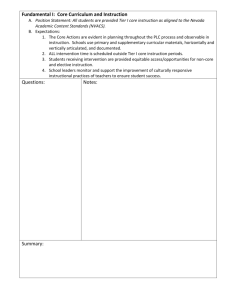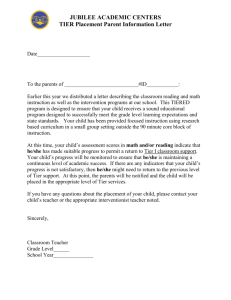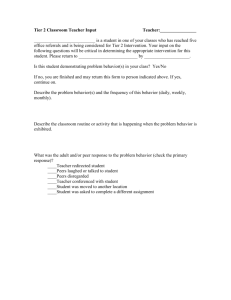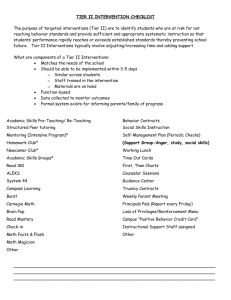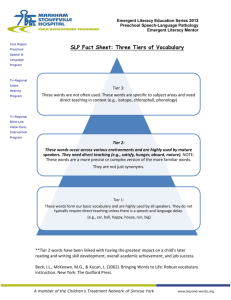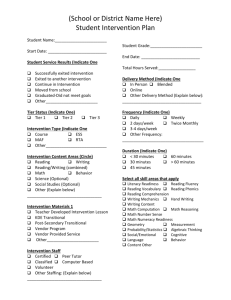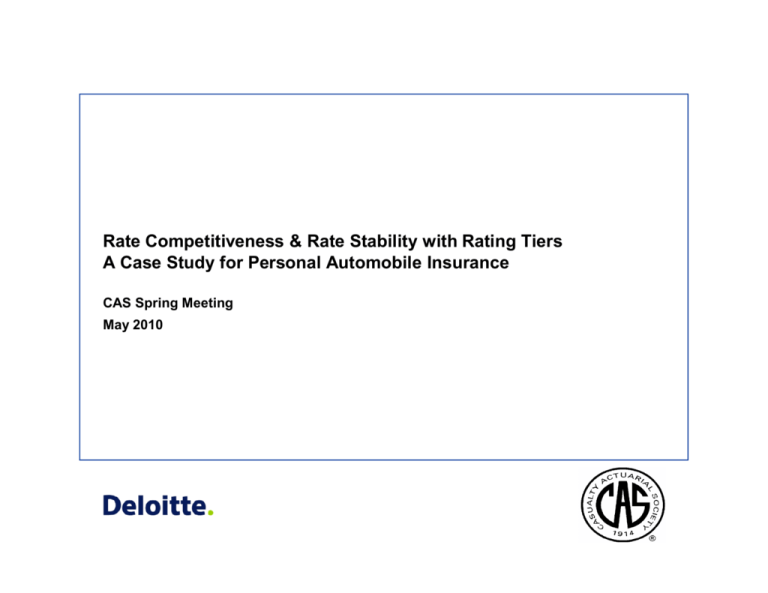
Rate Competitiveness & Rate Stability with Rating Tiers
A Case Study for Personal Automobile Insurance
CAS Spring Meeting
May 2010
Outline
Introduction
3
Model Design Discussion
6
Personal Auto Case Study
12
Conclusion
31
Q&A
33
Appendix
34
Introduction
Introduction
Generalized Linear Models (GLMs) as a Standard Tool for Rating Plan Development
GLMs have gained traction as powerful modeling tools to enhance the insurance rating plan and improve
the accuracy of rating factors
GLMs Enhanced Usage
Challenges
Race in developing new and more complex insurance
pricing models
However, GLMs caused challenges for the industry,
especially on rate stability and regulatory compliance
¡ In the 1990s, Generalized Linear Models (GLM) were
introduced to actuaries for developing personal
automobile pricing
¡ Frequent change of rating plans invites multiple rating
products to be in production
¡ Now, GLMs are used as a standard powerful modeling
tool to enhance the insurance rating plan and improve
the accuracy of rating factors
¡ Personal line industry has embraced more complex
rating plans, such as adding new variables or including
interaction terms
¡ Price disruption on renewal business by new and more
complicated products
¡ Resources and efforts needed to manage several
different versions of a given rating plan is a significant
challenge to insurance companies
¡ Increases insurance companies’ competiveness in the
market place
—4—
Tier Rating Case Study v6.ppt
¡ Assists avoidance of adverse selection
Introduction
Maintaining a Consistent Base Plan using Tier Rating
One approach for maintaining rate stability is to divide the entire rating plan into two parts; an underlying
base class plan and a rating tier on top of the base class plan
• New or non-traditional rating variables (e.g.,
occupation, education, prior BI limit, etc.)
• Variables restricted by certain states, but not by
others (e.g., credit score, not-at-fault accidents,
etc.)
Rating
Tier
• Standard rating variables
(e.g., territories, drivers,
vehicles, coverage,
discounts, etc.)
Base
Class Plan
• Common across states
• Potential interactions (e.g.,
gender and age, driver age
and mileage, etc.)
—5—
Tier Rating Case Study v6.ppt
One major advantage of separating the base class plan and the rating tier is the
efficiency in managing the rating plan changes and price disruption for individual risks.
Model Design
Discussion
Model Design Discussion
Frequency-Severity Models vs. Pure Premium Models
Two different modeling approaches can be employed for the rating tier creation: Frequency-Severity vs.
Pure Premium
Frequency-Severity Approach
1) Determine Modeled
Frequency Estimate
• Frequency =
Claim Count / Exposure
2) Determine Modeled
Severity Estimate
• Severity =
Loss ($’s) / Claim Count
3) Estimate Pure
Premium by Combining
Estimates
• Pure Premium =
Frequency * Severity
¡ Advantage associated with the frequency-severity
modeling approach is the detailed insight available of the
distinct loss cost drivers between frequency and severity
Pure Premium Approach
1) Determine Pure Premium
Estimate Directly
• Pure Premium =
Loss($’s) / Exposure
The Frequency-Severity approach prescribes the product of two models, while the
Pure Premium approach requires one model.
—7—
Tier Rating Case Study v6.ppt
¡ The pure premium approach directly uses pure premium
as the target variable for the estimate
Model Design Discussion
Frequency-Severity Models vs. Pure Premium Models
The pure premium approach is our preferred methodology for the development of rating tiers because the
frequency-severity approach has the following issues
More Effort and Less Efficient
Data Credibility
• Need to double the number of models
• For example, liability coverage might lack data
volume for its severity models
Frequency-Severity
Approach Issues
Model Disconnect
• Do both models have the same variables?
• Do both models treat a given variable in similar
fashion?
• Does severity distribution vary among
segments of the book?
Difficulty in Splitting Class Plan
Factors Between Frequency and
Severity Effects
• How to split the resulting class plan factors
between the frequency and severity
contributions when evaluating rating factors?
1 - For the pure premium approach, the Tweedier distribution, a compound distribution of Gamma and dispersed Poisson, is the sta ndard distribution assumption. The Tweedie distribution is part of the GLM and
the Exponential family distributions, and is currently available in many modeling software applications.
—8—
Tier Rating Case Study v6.ppt
The above issues regarding the Frequency/Severity approach lead us to believe that
the Pure Premium approach1 is a preferred approach for the rating tier development.
Model Design Discussion
Setting up the Pure Premium Distribution
The pure premium distribution is assumed to follow the Tweedie Distribution
Pure Premium Distribution
¡ Claim count is Poisson distributed
¡ Size-of-Loss is Gamma distributed
¡ Since Pure Premium equals Frequency * Severity, the resulting distribution is a
Gamma-Poisson distribution (i.e., the Tweedie Distribution)
¡ Therefore, the Tweedie Distribution harmonizes the compound effect of the Gamma
Severity and Poisson Frequency distributions
¡ The Tweedie Distribution belongs to the Exponential Family of Distributions, where:
oVar(PP) = fmp
§f is a scale parameter
§p є (1,2)
Øp is a free parameter – must be supplied by the modeler
ØAs p à 1: Pure Premium approaches the Over-Dispersed Poisson
ØAs p à 2: Pure Premium approaches the Gamma
—9—
Tier Rating Case Study v6.ppt
§m is the expected value of PP
Model Design Discussion
Selecting the “p value” for the Tweedier Model
We select the “p value” parameter which corresponds to the maximum log-likelihood
Max Log-Likelihood
at p=1.45
Poisson
PP Model Approaches
Gamma
Observations
¡ In determining the optimal result, we run a series of models with a changing “p value” (ceteris paribus) for
determining the Tweedie distribution “p value” assumption
¡ The log-likelihood function exhibits a smooth inverse “U” shape
— 10 —
Tier Rating Case Study v6.ppt
¡ The optimal “p value” selected corresponds to the model with the highest log-likelihood
Model Design Discussion
Vehicle Level Tiers vs. Policy Level Tiers
It is to our knowledge that the policy level tiers are more popular in the industry
Policy Level Design
Vehicle Level Design
Policy #: 00001
Policy #: 00001
Driver
Age
75
Vehicle
ID
Vehicle Tier
Assignment
1
38
0
19
2
¡ Able to use both vehicle level and police level variables
¡ In theory, vehicle level tiers are more accurate because it
allows different tier rates for each vehicle on a policy, while
policy level tiers assign the same tier rate for all vehicles on
the policy
Driver
Age
A
g
g
r
e
g
a
t
e
AVG
{75,38,19}
=
44
Policy Tier
Assignment
2
¡ While detailed vehicle level variables are available, some policy
level variable do exhibit correlation across all vehicles on a policy
(e.g., prior claims on other vehicles within policy)
¡ Efficiency gained by a policy level design typically outweighs the
marginal compromise of accuracy from a vehicle level design
¡ Easily extended and integrated into other applications (e.g.,
Underwriting and Marketing purposes)
— 11 —
Tier Rating Case Study v6.ppt
Vehicle
ID
Personal Auto
Case Study
Personal Auto Case Study
Data Details
The data used in the study is a subset of actual industry data and contains the following specifications
Detail
Line of Business
Private Passenger Auto
Coverages
(1) Personal Injury Protection (PIP)
(2) Collision (COLL)
Policy Year
2005
Term
Annual Policies
Single Car Policies
40,628
Multi Car Policies
48,353
Vehicles Level Records
on All Policies
175,004
Source: Deloitte Research
— 13 —
71% of vehicles purchase both coverages
29% of vehicles purchase PIP only
Tier Rating Case Study v6.ppt
Component
Personal Auto Case Study
Data Details (continued)
The rating variables used in the study
Variable
Target or Base/Tier
Territory
Base
{T1, T2, T3, T4, T5}
Type of Policy (TYPE)
Base
{M,S}
Driver Age Group
Base
{Youthful, Mature, Senior}
Vehicle Use
Base
{P, W}, P – Pleasure Use, W – Others
Vehicle Age Group
Base
{1, 2, 3, 4, 5}, the higher, the older
COLL Deductible
Base
{<=250, 500, >=1000}
Vehicle Symbol Group
Base
{1, 2, 3, 4, 5}
At Fault Accidents (AFA)
Base
{0, 1, 2+}
Credit Score Group
Tier
{0, 1, 2, 3, 4}, the higher, the better
Vehicle Level Not At Fault
Accidents (NAFA)
Tier
{0, 1, 2+}
Policy Level Not At Fault
Accidents (NAFA_POL)
Tier
{0, 1, 2+}
— 14 —
S – Single Car, M – Multi Car
Tier Rating Case Study v6.ppt
Source: Deloitte Research
Values
Personal Auto Case Study
Developing the Base Class Plan
The first step is to select a subset of variables (five for PIP, and eight for COLL) for the base class plan
and estimate the associated class plan factors for each coverage using pure premium Tweedie approach)
Territory
Driver Age
Vehicle Use
Type
AFA
Vehicle Age
Group
Symbol
Deductible
Value
T1
T2
T3
T4
T5
Young
Senior
Mature
P (Pleasure)
W (Other)
M (Multi Car)
S (Single Car)
0
1
2
1
2
3
4
5
1
2
3
4
5
250
500
1000
PIP Rating Factor
(Tweedie P=1.45)
0.771
0.768
0.577
0.887
1.000
1.294
1.020
1.000
0.870
1.000
0.705
1.000
0.778
0.709
1.000
COLL Rating Factor
(Tweedie P = 1.25)
0.845
0.904
0.858
0.901
1.000
1.327
1.067
1.000
0.944
1.000
0.965
1.000
0.868
0.929
1.000
2.990
3.022
2.394
1.879
1.000
0.732
0.824
0.915
0.980
1.000
1.354
1.253
1.000
Source: Deloitte Research
— 15 —
Observations
¡ We recognize the reversal in the atfault accident (AFA) factors between 0
and 1 for PIP, as well as in the Vehicle
Age factors between 0 and 1,
however, these results are from the
natural volatility of the data as well as
model indications
Tier Rating Case Study v6.ppt
Variable
Personal Auto Case Study
Developing the Base Class Plan
As an aside, the class plan factors in the previous slide are the optimized result by applying the GLM
Tweedie assumption to the data
Observations
¡ In determining the optimal result, we try a series of
“p” values for the Tweedie distribution assumption
¡ For each coverage, 17 models were constructed by
changing the “p” parameter from 1.10 to 1.90 in 0.05
increments
¡ The table shows the log likelihoods for the PIP and
COLL models are “U-shaped” with an increasing
“p” parameter
The optimal “p” value was identified to be 1.45 for the PIP model and 1.25 for the
COLL model. PIP has a higher “p” value that COLL because it is more severity driven.
Source: Deloitte Research
— 16 —
Tier Rating Case Study v6.ppt
Log-Likelihoods
Tweedier
p
PIP
COLL
1.10
-781.3
-12728.2
1.15
-713.6
-12494.7
1.20
-660.4
-12338.8
1.25
-619.1
-12262.3
1.30
-588.1
-12269.2
1.35
-566.0
-12367.1
1.40
-552.1
-12567.1
1.45
-546.1
-12886.6
1.50
-548.0
-13351.1
1.55
-558.8
-13998.8
1.60
-579.9
-14888.8
1.65
-614.3
-16114.9
1.70
-667.3
-17835.0
1.75
-748.4
-20334.9
1.80
-877.6
-24187.6
1.85
-1101.4
-30732.1
1.90
-1559.6
-43987.4
Personal Auto Case Study
Developing the Base Class Plan
After determining the class plan factors, we derive the base premium by achieving premium neutral
between the actual premium and the new modeled premium
Sum of
Actual
Premium
Sum of
Modeled
Premium
¡ Need to determine a new base premium so that the
sum of modeled premium equals the sum of actual
premium
PIP
COLL
$466.78
$211.31
Source: Deloitte Research
— 17 —
Tier Rating Case Study v6.ppt
Base Premium
Personal Auto Case Study
Tier Rating Model Design
The purpose of tier rating is to select a new subset of variables, most likely exclusive of those in the base
class plan, to sit on top of the base class plan. We will use two variables, Not At Fault Accidents and
Credit Score, for the rating tier design
Not At Fault Accidents (NAFA)
Modeling Variables
Policy #: 00001
Vehicle
NAFA
(Vehicle Level)
0
NAFA
(Vehicle Level)
NAFA_POL
(Policy Level)
0
1
¡ For NAFA_POL, the blue car will
indicate one not at fault accident
due to the NAFA experienced by
the red car because NAFA_POL
looks across all vehicles on a
policy
¡ NAFA has proven to correlate
with loss and there is a trend of
using NAFA as a tier factor
1
1
1
Credit Score
¡ Credit score has proven to strongly correlate with auto losses
The rating tier will be built at policy level, therefore
NAFA_POL and Credit Score will be used.
Source: Deloitte Research
— 18 —
Tier Rating Case Study v6.ppt
¡ Some states ban credit scores, therefore, using credit score as a tier factor allows rating flexibility between
different states
Personal Auto Case Study
Tier Rating Model Design Based on Pure Premium Approach
The model below indicates the specifications for a pure premium coverage specific model for PIP
Model #1
log( E (PP pip )) = log( E (
pip_loss
)) = log(pip_class_factor) + b × X
pip _ exposure
¡ The model is coverage specific, and the equation above illustrates the PIP coverage model
¡ PIP_Class_Factors
used as the “offset”
term
¡ The target is the pure premium, which is the loss over the exposure for the given record and the given coverage
¡ The pip_class_factor reflects the combined effect of the class plan for PIP, i.e., territory, driver age, multi-car policy
indicator, vehicle type, and at-fault accidents (AFA)
¡ X is the vector composed with the two tier elements: Credit Score and NAFA_POL Placeholder
¡ The theoretical distribution assumed is a Tweedier Distribution
¡ Used a Tweedier “P” value of 1.45
¡ Assume the class plan is multiplicative, therefore the “log” link function is used
¡ Use weight of pip_exposure (in this case since the case study only uses annual term policies, all of the weights = 1)
Source: Deloitte Research
— 19 —
Tier Rating Case Study v6.ppt
¡ Use an offset of Log(pip_factor)
Personal Auto Case Study
Tier Rating Model Design Based on Loss Ratio Approach
The model below indicates the specifications for a loss ratio coverage specific model for PIP
Model #2
log( E ( LR pip )) = log( E (
pip_loss
1
´
)) = b × X
pip_exposure pip_class_factor
¡ Coverage: PIP
¡ Target Variable: Loss ratio
¡ X (or Predictive Variables): Credit Score and NAFA
Multiplicative result of exposure and class
factor is essentially the same as premium.
¡ Theoretical Distribution: Tweedier
¡ Tweedier P: 1.45
Therefore, the model essentially becomes
a loss ratio model (i.e., loss over premium)
¡ Link Function: Log
¡ Weight: PIP Premium
¡ Offset: None
Source: Deloitte Research
— 20 —
Tier Rating Case Study v6.ppt
A pure premium model with offsetting base class plan factors is the same as a loss ratio model.
With the loss ratio as the target variable, the above model no longer needs the offset mechanism
Personal Auto Case Study
Tier Rating Model Result
The table below illustrates the parameter estimation difference between the pure premium and loss ratio
coverage specific models
NAFA_POL
COLL
Results:
Credit Score
NAFA_POL
P value = 1.45
1.002
1.049
0.395
0.194
0.000
0
1
2
-0.249
-0.834
0.000
Model 2: Loss Ratio Model
Rating
Parameter Estimate
Factor
2.724
2.855
1.484
1.214
1.000
P value = 1.45
1.011
1.026
0.396
0.196
0.000
2.749
2.789
1.486
1.217
1.000
0.780
0.434
1.000
-0.308
-0.867
0.000
0.735
0.420
1.000
0
1
2
3
4
P value = 1.25
0.371
0.249
0.161
0.171
0.000
1.449
1.282
1.174
1.187
1.000
P value = 1.30
0.370
0.244
0.153
0.167
0.000
1.447
1.276
1.165
1.182
1.000
0
1
2
-0.317
-0.255
0.000
0.728
0.775
1.000
-0.319
-0.255
0.000
0.727
0.775
1.000
Observations
¡ In general and as expected, the
optimal p values for the tier models
are the same as, or close to, the
base class plan models
¡ The maximum likelihood estimates
calculated by the two generalized
linear models are not exactly the
same, but remain very close
¡ Parameters for both credit score and
not-at-fault accidents are significant,
suggesting that they can further
segment the risk beyond the
underlying base class plan
The results given above demonstrate how we can remove the underlying class plan effect in establishing the rating tier
factors via the use of premium for the loss ratio approach and the combined class plan factor for the pure premium approach.
— 21 —
Tier Rating Case Study v6.ppt
Variable
Value
PIP
Results:
Credit Score
0
1
2
3
4
Model 1: Pure Premium Model
Parameter
Rating
Estimate
Factor
Personal Auto Case Study
Tier Rating Model Design
The model below indicates the specifications for a loss ratio all coverages combined model
Model #3
total_loss
)) = b × X
log( E (LR total )) = log( E (
total_premium
¡ Coverage: PIP and COLL
¡ Target Variable: Loss ratio
¡ X (or Predictive Variables): Credit Score and NAFA_POL
¡ Theoretical Distribution: Tweedier
¡ Tweedier P: 1.35
¡ Link Function: Log
¡ Weight: Total Premium
The all coverages combined option is not valid for the pure premium model design since
we cannot add exposure or combine the class plan factors across different coverages.
Source: Deloitte Research
— 22 —
Tier Rating Case Study v6.ppt
¡ Offset: None
Personal Auto Case Study
Tier Rating Model Result
Coverage Specific: PIP
(Optimal P Value = 1.45)
All Coverages Combined
(P Value = 1.35)
Coverage Specific: COLL
(Optimal P Value = 1.30)
Variable
Value
Parameter
Estimate
Rating Factor
Parameter
Estimate
Rating Factor
Parameter
Estimate
Rating Factor
Credit_Score
0
1.011
2.749
0.561
1.752
0.370
1.447
Credit_Score
1
1.026
2.789
0.492
1.636
0.244
1.276
Credit_Score
2
0.396
1.486
0.220
1.246
0.153
1.165
Credit_Score
3
0.196
1.217
0.175
1.191
0.167
1.182
Credit_Score
4
0.000
1.000
0.000
1.000
0.000
1.000
NAFA_POL
0
-0.308
0.735
-0.320
0.726
-0.319
0.727
NAFA_POL
1
-0.867
0.420
-0.405
0.667
-0.255
0.775
NAFA_POL
2
0.000
1.000
0.000
1.000
0.000
1.000
The combined coverages parameter estimates and the optimal p value fall between
the by-coverage results. Since COLL has more premium than PIP, the combined
estimates are slightly closer to the COLL estimates than the PIP estimates.
Source: Deloitte Research
— 23 —
Tier Rating Case Study v6.ppt
The parameter estimates and optimal p value resulting from the all-coverages-combined model fall
between the coverage specific model estimates
Personal Auto Case Study
Rating Tier Creation
The selected model design for which we will build tier rating scores from is the loss ratio all-coveragescombined model (i.e., Model 3)
Model #1
Model #3
• Pure Premium
Target
• Loss Ratio
Target
• Loss Ratio
Target
• Coverage
Specific
• Coverage
Specific
• All Coverages
Combined
Rating
Factor
1.752
1.636
¡ Take the results from Model 3
and apply the tier rating factors
to each of the risks. (Note: only
the tier rating factors are
applied, i.e., they are not
combined with the base plan
factors)
Policy
Model
Score
Tier
Assignment
001
0.561
4
002
0.172
3
003
-0.185
1
004
0
2
005
-0.23
1
…
…
…
1.246
1.191
1.000
0.726
0.667
1.000
Tier Assignment
¡ After applying the tier rating
factors, each risk will receive a
“tier rating score”
¡ Next, we will group the risks
into four rating tiers based on
their tier rating score
— 24 —
Tier Rating Case Study v6.ppt
Model #3:
All Coverages Combined
(P Value = 1.35)
Parameter
Variable
Value
Estimate
Credit
0
0.561
Score
Credit
1
0.492
Score
Credit
2
0.220
Score
Credit
3
0.175
Score
Credit
4
0.000
Score
NAFA
0
-0.320
POL
NAFA
1
-0.405
POL
NAFA
2
0.000
POL
Model #2
Personal Auto Case Study
Rating Tier Creation
The table below shows the final distribution of premium, loss, and loss ratio by rating tier and coverage,
after grouping the risks into one of four rating tier based on their tier rating score
Policy
Level
Rating
Tier
PIP
Premium
COLL
Premium
PIP
Loss
COLL
Loss
PIP Loss
Ratio
COLL
Loss
Ratio
PIP
Tier
Factor
COLL
Tier
Factor
1
7,196,865
11,700,975
1,566,394
5,197,147
21.8%
44.4%
0.355
0.678
2
15,464,220
25,384,564
4,725,373
13,132,471
30.6%
51.7%
0.498
0.789
3
6,549,586
10,508,607
3,870,624
6,076,159
59.1%
57.8%
0.964
0.882
4
7,680,868
10,614,534
4,709,582
6,957,082
61.3%
65.5%
1.000
1.000
Total
36,891,539
58,208,680
14,871,972
31,362,859
40.3%
53.9%
Observations
¡ The indicated tier relativity are located in the last two columns. For example, if we use Tier 4 as the base (poor
experience) tier, we indicate a 32% (i.e., 1-0.678), 21%, and 12% discount to tier 1, 2, and 3 risks, respectively,
for their COLL premium
¡ The “final selected” tier factors for premium adjustment is also dependent on each company’s objectives
Source: Deloitte Research
— 25 —
Tier Rating Case Study v6.ppt
¡ The number of tier groups and the distribution of the risks can vary from one company to another, and is
dependent on each company’s business objectives. The “indicated” tier factors will depend on the selected tier
group number, as well as the distribution of risks
Personal Auto Case Study
Rating Tier Creation
A premium neutral result can be achieved by rebasing the tier factors
Policy
Level
Rating Tier
PIP
Premium
COLL
Premium
Initial PIP
Tier Factor
Initial COLL
Tier Factor
Final PIP
Tier Factor
Final COLL
Tier Factor
1
7,196,865
11,700,975
0.355
0.678
0.540
0.824
2
15,464,220
25,384,564
0.498
0.789
0.758
0.960
3
6,549,586
10,508,607
0.964
0.882
1.466
1.073
4
7,680,868
10,614,534
1.000
1.000
1.521
1.216
Total
36,891,539
58,208,680
0.657
0.822
1.000
1.000
Observations
By achieving the premium neutral, there will be no premium
gain or loss due to the introduction of the rating tier.
Source: Deloitte Research
— 26 —
Tier Rating Case Study v6.ppt
¡ A tier 1 policy will receive a 46% (i.e., 1 - 0.54) and 17.6% (i.e., 1 - 0.824) premium deduction for PIP and COLL
respectively
Personal Auto Case Study
Rating Tier Creation
The table below exhibits vehicle level tier factor estimates that would’ve resulted had we used a vehicle
level dataset, and compares it to the policy level tier factor estimates
Policy Level
Vehicle Level
Value
Parameter
Estimate
Value
Parameter
Estimate
Credit_Score
0
0.561
1.752
Credit_Score
0
0.566
1.762
Credit_Score
1
0.492
1.636
Credit_Score
1
0.495
1.641
Credit_Score
2
0.220
1.246
Credit_Score
2
0.225
1.252
Credit_Score
3
0.175
1.191
Credit_Score
3
0.176
1.193
Credit_Score
4
0.000
1.000
Credit_Score
4
0.000
1.000
NAFA_POL
0
-0.320
0.726
NAFA
0
-0.220
0.803
NAFA_POL
1
-0.405
0.667
NAFA
1
-0.033
0.967
NAFA_POL
2
0.000
1.000
NAFA
2
0.000
1.000
Variable
Rating Factor
Variable
Rating Factor
Observations
¡ Another difference between policy level rating tiers and vehicle level rating tiers is that for the vehicle level tier
rating, it is possible that different vehicles on a policy can be assigned to different tiers. Our study further indicates
that for the 48,353 multi-cars policies, 6.9% of the policies will have different tier assignments among the vehicles
within the given policy. Since the real word rating tiers typically contain more variables, the percentage should go
up even more in practice
Source: Deloitte Research
— 27 —
Tier Rating Case Study v6.ppt
¡ The indicated parameters for NAFA_POL are much stronger than the parameters for NAFA (vehicle level),
suggesting a vehicle on a multi-car policy with accidents of “other” vehicles on the same policy are correlated with
the vehicle’s future losses. This is why policy and family account level variables are being used in rating these days
Personal Auto Case Study
Premium Disruption
Analyzing and controlling premium disruption is a very critical step in implementing any rating plan
changes, with particular respect to regulation requirements
Premium Change
Credit
Score
NAFA
PIP
COLL
Total
1
4
1
-46%
-18%
-28%
1
4
0
-46%
-18%
-28%
1
3
1
-46%
-18%
-28%
2
2
1
-24%
-4%
-12%
2
3
0
-24%
-4%
-12%
2
2
0
-24%
-4%
-12%
3
3
4
1
2
1
47%
47%
7%
7%
22%
22%
3
0
1
47%
7%
22%
3
3
1
3
0
2
47%
47%
7%
7%
22%
22%
4
2
2
52%
22%
34%
4
0
0
52%
22%
34%
4
1
2
52%
22%
34%
4
0
2
52%
22%
34%
0%
0%
0%
Total
Source: Deloitte Research
— 28 —
Observations
¡ Since the premium impact associated
with the rating tier approach is
completely isolated within the rating
tier assignments and associated
factors, the premium disruption can
be quickly analyzed and understood
¡ Since the premium impact is isolated
within the rating tier assignments and
the associated tier factors, we can
control and manage the disruption
more efficiently by changing either the
factors or establishing additional tier
assignment rules
Tier Rating Case Study v6.ppt
Rating
Tier
Personal Auto Case Study
Premium Disruption
The table below compares PIP’s original base class plan (i.e., excluding a rating tier) with PIP’s completely
revised class plan with the inclusion of the rating tier factors
Value
Base Class Plan, PIP
Complete Class Plan, PIP
T1
T2
T3
T4
T5
$466.78
0.7711
0.7675
0.5765
0.8873
1.0000
$263.08
0.8008
0.7197
0.5791
0.8904
1.0000
Driver Age
Yng
Senr
Matr
1.2941
1.0203
1.0000
1.2971
1.4511
1.0000
Vehicle Use
P
W
0.8701
1.0000
0.9388
1.0000
Type
M
S
0.7045
1.0000
0.6884
1.0000
AFA
0
1
2
0.7776
0.7094
1.0000
0.8686
0.8335
1.0000
Base Premium
Territory
Credit Score
0
1
2
3
4
3.1012
3.3218
1.6706
1.2959
1.0000
NAFA_POL
0
1
2
0.7513
0.4269
1.0000
Source: Deloitte Research
— 29 —
Observations
¡ The revised class plan for PIP
includes NAFA_POL and credit
score in the class plan
¡ The table indicates that all the base
class plan factors have changed,
and some of them have a fairly large
change, such as AFA and senior
driver factor
¡ Such significant change in class
factors lead to increased difficulty in
managing premium disruption
¡ The significant change in class
factors require more effort for
implementation on filing and system
programming
Tier Rating Case Study v6.ppt
Variable
Personal Auto Case Study
Practical Considerations
The rating tier design provides insurance companies an excellent approach in managing an insurance
book with respect to rate distribution, rate disruption, and risk segmentation
¡ It is fairly easy to manage the rate distribution for the book using the rating tier approach. For example, we can
simply adjust the score cutoff to achieve different tier distributions.
¡ If the premium disruption is capped within a certain range due to business or regulatory reasons, we can simply
change the final selected factors to be in compliance with the capped range
• For example, if a state restricts premium change to +/- 20%, we can change the final selected factors to
0.80 for Tier 1 and 1.20 for Tier 4 in Table 4 for the state.
• Another example is that we can add a business rule so that if the premium disruption exceeds a certain
threshold for a risk, we can cap the change within the tier, such as Tier 2 to Tier 3, instead of to Tier 4
¡ Rating tiers allow a quick introduction of new variables if the variables have proven correlation with insurance
loss
Source: Deloitte Research
— 30 —
Tier Rating Case Study v6.ppt
• Rating tiers approach will not affect the underlying base class plan factors, there is no need to file a new
class plan. This will avoid multiple versions of class plans if certain factors, such as credit score, are
allowed in some states, but not in others
Conclusion
Conclusion
The preferred model design in this case study is at the policy level, using a loss ratio target, with the GLM
Tweedier assumptions
¡ Rating tier is an excellent pricing design to help insurance companies achieve a balance in rate stability and
rate complexity
¡ There are two approaches to develop rating tiers – pure premium modeling with an offset of base plan factor or
loss ratio modeling. Both modeling will use GLM Tweedier assumption
¡ There are two different designs – policy level or vehicle level. It is more popular and more efficient to use
policy level rating tier design
¡ The case study given in the paper is somewhat ideal and simplified. The real world applications will require
considerable additional amount of work, especially on data preparation and data adjustments.
• For example, for loss ratio modeling, the premium re-rate could be much more complicated. For loss,
we need to develop it to ultimate level and trend it to be consistent with on level premium period
§ We can develop an additional underwriting tier with the same methodology, by maintaining flexibility to
implement the rating tier and the underwriting tier in different fashions
§ Add the rating tier into the existing rating plan using the underwriting tier for company placement
Source: Deloitte Research
— 32 —
Tier Rating Case Study v6.ppt
§ Combine the rating tier and the underwriting tier for underwriting purposes
Q&A
Appendix
Appendix
Expanding the Application
Tier rating can be expanded to Underwriting applications, thereby increasing efficiency in predictive
modeling efforts
Predictive Modeling
Efficiency
Generate the first
level tier only
using rating
variables
Maintain the
current class plan
structure and class
rating factors with
no change
Generate the second
level tier using nonrating underwriting
variables in tandem
with the first tier
Implementation Options
Option 1
§ Add the first level tier to the
current class plan for rating
§ Using the second level tier for
underwriting
Option 2
§ Use level one and level two
tiers simultaneously for
underwriting
§ Risk Selection
Source: Deloitte Research
— 35 —
Tier Rating Case Study v6.ppt
§ Company Placement
Copyright © 2010
2009 Deloitte Development LLC. All rights reserved.

